What Is a BRAS?
A BRAS is an access gateway oriented to broadband network applications. It bridges broadband access and backbone networks, providing basic access methods and management functions for broadband access networks. It usually functions as a core node on an Internet service provider (ISP) network, allowing users to connect to a network through different access modes (such as DSL, optical fiber, and satellite). Furthermore, it provides a wide range of functions, such as authentication, authorization, accounting, and traffic control, to ensure the quality and security of network connections.
How Does a BRAS Work?
As a new type of access gateway oriented to broadband network applications, a BRAS allows users to remotely access broadband network resources through local computers. This network device bridges broadband access and backbone networks, and provides basic access methods and management functions for broadband access networks. On the network shown in the following figure, after receiving a connection request from a user, the BRAS processes the packet before accessing the backbone network. This solves certain problems of traditional networks: lacking user authentication and authorization mechanisms, and inconvenient for operations and management.
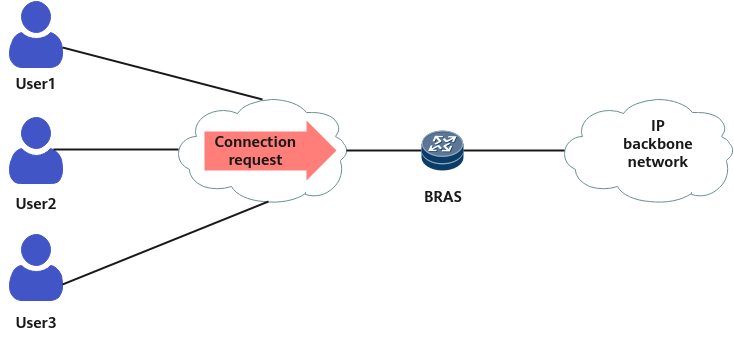
BRAS functions
Key Technologies of the BRAS
The BRAS implements two main functions. One is network transport, including user authentication and authorization, IP address assignment, data traffic control, security policy implementation, and service quality assurance. The other is control implementation. This function works with the authentication, charging, customer management, and service policy control systems to implement user access authentication, charging, and management.
As shown in the following figure, the BRAS consists of five functional components: user access identification, connection management, AAA and user management, address assignment and management, and service control.
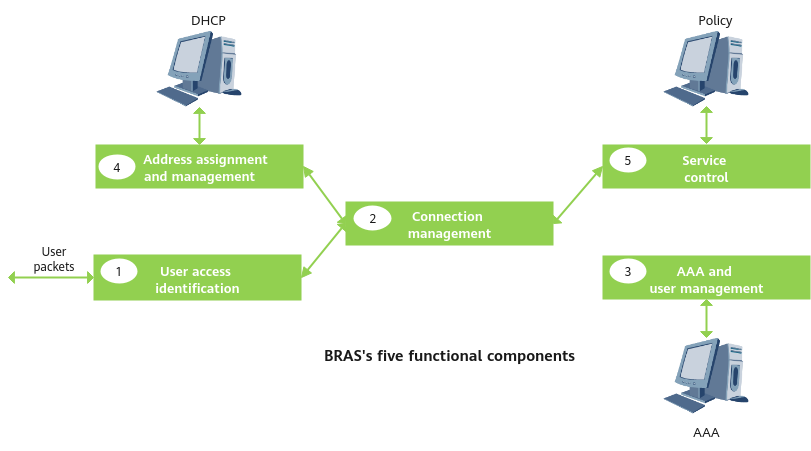
BRAS's five functional components
The following figure shows the basic service handling process of the BRAS based on its five functional components.

BRAS service handling process
The following sections describe the evolution of the BRAS deployment solution: from the traditional BRAS solution to the vBRAS solution (also called cloud-based BRAS solution), and then to the iBRAS solution.
Traditional BRAS Solution
Traditional Distributed BRAS Deployment Solution
As shown in the following figure, traditional BRASs are deployed in distributed mode and fully meshed with peripheral systems such as servers and user terminals. Because each BRAS needs to interconnect with peripheral devices, problems such as low deployment efficiency, heavy configuration workload, and difficult maintenance exist. BRASs can manage both sessions and user bandwidth. When users go online from BRASs in different regions, resources are wasted due to uneven resource allocation, numerous sessions, and idle bandwidth.
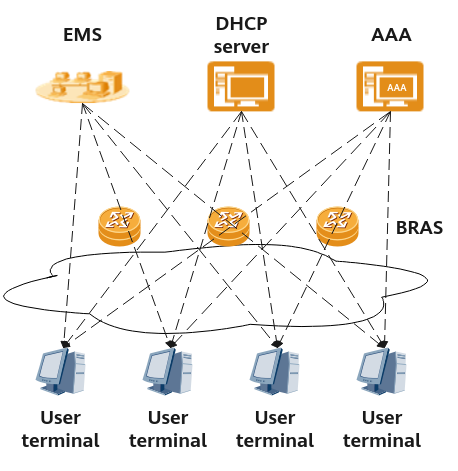
Traditional distributed BRAS deployment
Challenges for Traditional BRASs
As the number of home broadband users surges and emerging services such as 4K high definition (HD) and Internet of Things (IoT) develop rapidly, the traditional distributed BRAS deployment solution faces the following significant challenges:
- Low resource utilization
When traditional BRASs function as both user access authentication and accounting gateways and Layer 3 edge devices on IP networks, the control and forwarding planes are tightly coupled together. As a result, the processing performed by each plane affects the performance of the other plane, meaning that the performance of the two planes cannot be fully utilized.
- Complex management and maintenance
Because there are many traditional BRASs deployed, you need to configure BRASs one by one when deploying a global service policy on a network. As networks expand in scale and new services are introduced, it is difficult to efficiently manage services and quickly rectify faults using this configuration mode.
- Slow service provisioning
The control and forwarding planes are tightly coupled, and the distributed network control mechanism is used. As a result, the introduction of any new technology relies heavily on devices on the live network. And because multiple devices are updated synchronously, it takes a long time to deploy new technologies, severely restricting network evolution and development.
To accelerate service rollout, improve resource utilization, and simplify O&M, the vBRAS and iBRAS solutions are developed.
vBRAS Solution
vBRAS Architecture Featuring CUPS
vBRAS, short for virtual broadband remote access server, adopts an architecture based on virtualization technologies. It virtualizes traditional hardware BRAS functions and implements software-based network functions, improving network flexibility and scalability.
On core networks, control and user plane separation (CUPS) evolution is implemented to improve resource utilization and simplify O&M, thereby achieving a flexible and scalable network architecture and improving both network performance and efficiency. The BRAS is at the core of the broadband access network and plays an important role, including controlling and managing user access and forwarding user data. Control and forwarding are two different processes on a BRAS. Control involves operations such as authentication, accounting, and rate limiting for users, and forwarding involves data forwarding for users. To improve the performance and reliability of BRASs, the control plane (CP) is separated from the user plane (UP) to form the vBRAS architecture featuring CUPS.
To decouple the CP from the UP, different hardware devices are used to handle the operations involved in control and forwarding. This helps optimize and extend different handling processes, improve system stability and performance, and facilitate system management and maintenance by a network administrator. The following figure shows how the CP and UP of the vBRAS are decoupled.
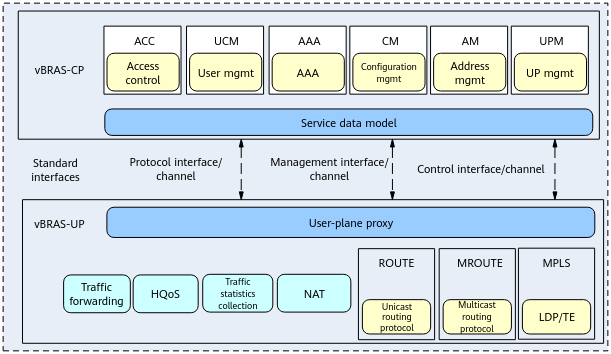
vBRAS architecture featuring CUPS
- CP
In the CUPS architecture, user management functions on multiple BRASs are extracted and centralized to form a CP. The vBRAS-CP is a user control and management component that consists of functional modules, such as user access control (ACC), user management (UCM), authentication, authorization, and accounting (AAA), address management (AM), and UP management (UPM) modules.
- UP
In the CUPS architecture, the CP of the router and the UP of the BRAS are retained to form a UP. The vBRAS-UP is a Layer 3 network edge and user policy enforcement component that provides pure forwarding-plane functions (such as traffic forwarding, QoS, and traffic statistics collection) and pipe control-plane functions (such as dynamic routing protocol functions).
Huawei's CUPS vBRAS architecture consists of the control-plane NE (vBRAS-CP) and the user-plane NE (vBRAS-UP), which work together to implement BRAS functions. vBRAS-CPs are deployed in core DCs, and vBRAS-UPs are deployed in traditional aggregation equipment rooms. The CP is centrally deployed on the cloud to fully utilize the strong computing capabilities of the cloud. A single rack can manage tens of millions of users. The UP is deployed in a distributed manner and uses high-performance hardware to process large-bandwidth and low-delay services — the forwarding capability of a single rack can reach the Tbps level.
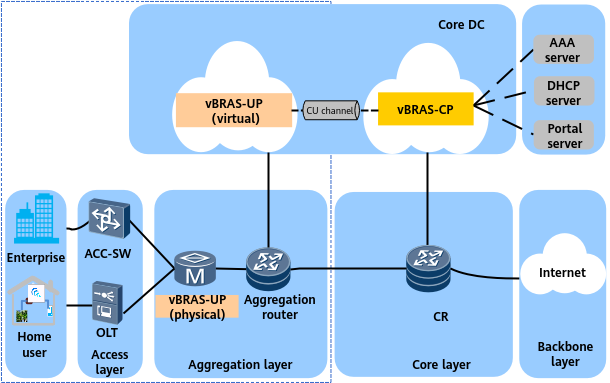
vBRAS CUPS deployment scenario
vBRAS Solution
The vBRAS solution featuring the cloud-based CUPS architecture is implemented based on the centralized management and control capabilities brought by software-defined networking (SDN) and the device cloudification capabilities brought by Network Functions Virtualization (NFV). BRAS user management functions that are computing-intensive are cloudified and centralized in order to retain the high forwarding performance of BRASs. This solution meets key requirements, such as function, performance, maintainability, and rapid service rollout requirements on live networks.
The vBRAS solution complies with the NFV architecture and cloudifies traditional BRAS functions. NFV is a network architecture in which traditional network devices are virtualized into software modules running on universal hardware. The vBRAS solution focuses on unified management of vBRAS-vUPs and vBRAS-pUPs, and uses the CUPS vBRAS architecture mentioned earlier. The CUPS architecture is the most cost-effective solution for evolving toward the all-cloud era.
As shown in the following figure, BRAS (such as AAA, DHCP, and RADIUS) and CP functions are implemented by virtual universal servers and software. The UP functions are implemented by physical BRASs or universal servers and software. Physical BRASs ensure low-delay forwarding of heavy traffic, and virtual universal servers and software process light-traffic services that have many concurrent sessions. The vBRAS solution not only virtualizes physical BRAS functions, but also flexibly schedules virtualized compute, storage, and network resources after cloudification. Furthermore, it provides IT capabilities as services for on-demand use. In addition, the vBRAS solution can carry all services, including HSI, IPTV, VoIP, and IMTS. As such, this solution is applicable to heavy-traffic and multi-service applications.

vBRAS solution
iBRAS Solution
iBRAS Solution Architecture
As the volume of network traffic continues to burgeon, carriers have increasingly strong demands for network optimization and differentiated services. Huawei's iBRAS solution (Intelligent Broadband Engine Solution) helps carriers implement refined operations.
The iBRAS solution integrates diverse functions such as traffic management, application acceleration, traffic monetization, traffic mirroring, flow log recording, experience O&M, marketing application, and information push. It leverages multiple patented service awareness technologies to analyze and process network data packets through a high-performance hardware platform. In addition, it provides intelligent and flexible service control methods to implement traffic analysis, bandwidth management, and network security protection on fixed, wireless, and converged networks.
The iBRAS solution consists of the Front End and Back End. The Front End monitors traffic, enforces and applies policies, and reports statistics. The Back End configures policies and collect statistics.
- Front End
This function is implemented by the service awareness (SA) board installed on the BRAS or SR. The Front End performs in-depth analysis of network and application indicators. Based on the analysis, it establishes an indicator system and performs service modeling for applications, poor-QoE, fault demarcation, and potential customers. It also provides functions such as Internet access quality analysis, single-user quality query, potential customer identification, and VIP experience assurance to support poor-QoE rectification and precision marketing.
- Back End
This function is implemented by the Versatile Business Platform (VBP) connected to the BRAS. The VBP Back End, the core component of the iBRAS system, provides comprehensive device management and monitoring functions, including device management, user management, traffic management, security management, and log management.

iBRAS solution architecture
Comparison Between BRAS Solutions
The following table describes the characteristics of the three BRAS solutions. The vBRAS and iBRAS solutions developed upon the traditional BRAS solution can adapt to heavy-traffic and multi-service scenarios and provide differentiated services and refined operations capabilities for carrier networks.
Solution |
Deployment Mode |
Characteristics |
Applicable Scenario |
|---|---|---|---|
Traditional BRAS solution |
Distributed deployment solution |
|
Applicable to single-service scenarios with light traffic |
vBRAS solution |
Unified management of vBRAS-vUPs and vBRAS-pUPs |
|
Applicable to scenarios with heavy traffic and multiple services |
iBRAS solution |
Collaboration with the BRAS Front End (installed SA boards) and VBP Back End |
|
Applicable to carrier networks that have high requirements on differentiated services and refined operations |
- Author: Guo Yuhan
- Updated on: 2023-08-01
- Views: 8800
- Average rating:






